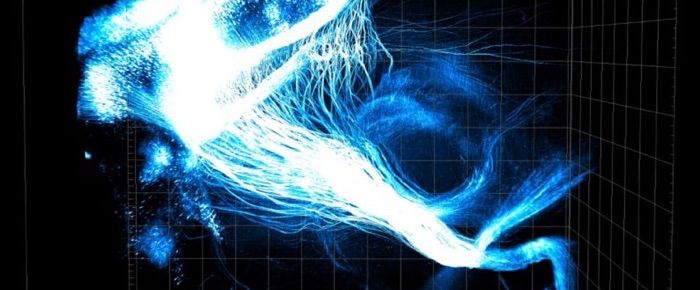 3D CLARITY image shows neural connections from the prefrontal cortex across an entire transparent mouse brain. (Image credit: Li Ye and Karl Deisseroth)
3D CLARITY image shows neural connections from the prefrontal cortex across an entire transparent mouse brain. (Image credit: Li Ye and Karl Deisseroth)
- Written by Stanford News
Stanford research shows that different brain cells process positive and negative experiences
FeaturedCombining two cutting-edge techniques reveals that neurons in the prefrontal cortex are built to respond to reward or aversion, a finding with implications for treating mental illness and addictions.
The prefrontal cortex plays a mysterious yet central role in the mammalian brain. It has been linked to mood regulation, and different cells in the prefrontal cortex seem to respond to positive and negative experiences. How the prefrontal cortex governs these opposing processes of reward or aversion, however, has been largely unknown. In a new paper published online in Cell, researchers at Stanford, led by Karl Deisseroth, have united two transformational research techniques to show how the prefrontal circuits that process positive and negative experiences are distinctly and fundamentally different from one another both in how they function and in how they are wired to other parts of the brain.
"These cells are built differently," said Dr. Deisseroth, Professor of Bioengineering and of Psychiatry and Behavioral Sciences at Stanford University. “They didn’t start the same and then change their nature with recent experience. They appear wired specifically to communicate positive or negative experience.”
This has deep implications for both our understanding of how reward and aversion work, but also for the potential development of drugs or other therapies to treat drug addiction and mental illnesses tied to reward and aversion.
Read the full article at Stanford News.
Visible Legacy Comment
This story epitomizes a progression of multidisciplinary team success that the lab members can be proud to be known for and can be traced with the Visible Legacy Navigator. It is also an example of the impact of Foundation funding of research. The outcomes should be of interest to Tech Scouts seeking innovations and scientists.
The basic science is exciting because it provides valuable new insights into the workings of the brain and behavior. Tech Scouts might be interested in drilling in to two aspects of this project: CLARITY and optogenetics. CLARITY is a hydrogel process that renders tissues transparent and potentially ushers in an entirely new era of whole-organ imaging. Optogenetics uses light to control the activity of the brain (in tissue prepared with specific proteins) and allows investigation of neural disorders like Parkinson's disease and can be envisioned to help with behavior like depression or anxiety, and may also inform drug discovery or guide existing neural stimulation techniques. In the map one can also trace the impact of Foundation funding beginning with the Coulter Foundation early on followed by HHMI and NIH. The impact of these funders can be quantified in the projects, innovations for license, additional follow-on funding, grad students finding their own professorships, and startups such as Circuit Therapeutics.
The ecosystem we have mapped here was described (in prose) in a blog by Maria Freire, President and Executive Director of the Foundation for the National Institutes of Health, as an example of the need for increased funding of the NIH. She was successful and Congress awarded NIH a $2 billion increase. As we better visualize the participants in the ecosystem, we can help how Foundations show the impact of their philanthropic strategy and speed the translation of research to industry solving global problems.
See the latest research from the ecosystem by exploring the map below!
updated 161003.4
Additional Info
-
Navigator:
 Explore the map in Navigator
Explore the map in Navigator - Widget:
- Caption: The Deisseroth Lab at Stanford has developed optical neuroengineering technologies for noninvasive imaging and control of brain circuits, as they operate within living intact tissue, in real time. The team are employing and further developing these tools to probe neural circuit dynamics with millisecond temporal resolution. They hope that outcomes of this work will include fundamental new conceptualizations of neurological and psychiatric disorders, basic neuroscience and bioengineering insights, and potent, specific circuit-modulation interventions for treatment of disease. The laboratory is based in the James H. Clark Center at Stanford and employs a wide range of techniques including neural stem cell and tissue engineering methods, electrophysiology, molecular biology, neural activity imaging, animal behavior, and computational neural network modeling.
Related items
- The future of health care is in our cells
- Federal funding will help WSU professor develop technology to recover rare earth elements
- Unlocking the brain: Peptide-guided nanoparticles deliver mRNA to neurons
- Scientists Get to the Bottom of COVID’s Worst Pediatric Complication
- WSU-inspired national gene-editing task force begins work
